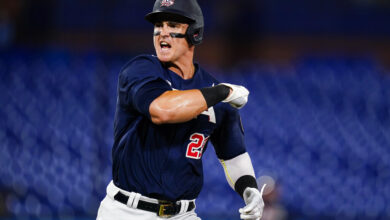
Cubs Will ‘Almost Certainly’ Shop Willson Contreras Sans Extension
Team Would Be Wise to Retain All-Star Catcher
The titular concept feels pretty much like a given in light of the trade deadline reckoning Jed Hoyer just oversaw, but the Cubs’ options for Willson Contreras aren’t all that simple. I mean, yeah, it’s probably not much more complicated. When you dig into it a little, though, the context around the decision shifted as a result of those other trades and the timing of this whole thing.
Sahadev Sharma wrote in The Athletic that “Hoyer will almost certainly shop [Contreras]” if an extension can’t be reached, which in and of itself isn’t a novel concept. However, there’s a last-man-standing vibe with Contreras as the remaining core position player from a group of fan favorites that have otherwise been sent packing. Just from a fan-service perspective alone, trading him would be tough.
Then you factor in his diminishing value, both from decreased contractual control and increased age. Contreras has just one year left on his rookie deal and he’ll turn 30 next season, not exactly enticing factors when considering a potentially overused catcher who relies heavily on his athleticism. Had the Cubs really wanted to get value in return for their All-Star catcher, they should have traded him either at the deadline or well before.
Interestingly enough, the very things that might make Contreras less valuable on the trade block and/or open market are what could make him a more prime extension candidate. While Hoyer has said otherwise publicly, the Cubs didn’t really get very far down the road — maybe didn’t even leave the driveway in some cases — when it came to contract talks with their other stars.
The result is that they should have quite a bit of room in the budget to extend Contreras at a reasonable rate, particularly if it means buying out what is expected to be a roughly $9 million salary in his final year of arbitration. J.T. Realmuto got $23.1 AAV for five years ahead of his age-28 season, so it’s hard to imagine Contreras coming anywhere near that. Might $70-80 million over four years get it done, though?
Such a deal would give him a good measure of security without adding too much to the Cubs’ salary projections for 2022. Of course, even $17.5-20 million AAV might be too rich for a club that has talked openly about not spending big on a players’ declining years. Then again, Hoyer spoke about Contreras suffering from overuse during a season that saw the Cubs employ roughly 43 backup catchers.
“We did have that revolving door at catcher, felt like we could never keep anyone healthy,” Hoyer explained. “[David] Ross and I talked about it throughout the year. It was hard to not play Willson a lot, but he definitely got worn down. I think he’s an elite offensive player. But it’s hard to be an elite offensive player when your legs are gone.
“That’s something we have to really focus on this offseason, building a roster and setting it up to make sure that we can keep Willson as an elite offensive player.”
This is an issue that’s dated back to at least 2018, when Contreras admitted that failure to stick with his workout routine caused his production to crater. Part of the reason the Cubs haven’t really been all that serious about moving him is that doing so would have meant going with a cast of career backups for the entire season, particularly when heir apparent Miguel Amaya hasn’t necessarily developed the way everyone expected.
A big part of that was the lost 2020 season, then came injuries that limited him to just 103 plate appearances through June 3 at Double-A Tennessee. Amaya will only be 23 in March, though, at which point he’d still be a year younger than Contreras was when he made his MLB debut in 2016. And you have to remember that Contreras was third on the depth chart during a rookie campaign in which his 389.2 innings behind the plate trailed both David Ross (448.2) and Miguel Montero (558.1).
And though Contreras assumed a more everyday role with 821.1 innings as a catcher in 2017, Montero still logged 215.1 innings prior to being traded to Toronto in early July of that season. Contreras logged over 1100 innings in that aforementioned 2018 that saw him post career-lows of 101 wRC+ and 0.7 fWAR and it was clear he had bonked. A hamstring injury cost him a full month across most of August and part of September in 2019, but he managed to put up the best offensive numbers of his career in more limited action.
What I’m driving at here is that it makes the most sense for the Cubs to work out an extension with Contreras and then supplement him with a capable backup, perhaps even one who can take over in the near future. Assuming the DH comes to the National League along with the new CBA — the negotiation of which presents additional issues here — the Cubs have another avenue via which to ease their catcher’s burden.
If Amaya is able to stay healthy and develop as has been expected, having Contreras under contract wouldn’t necessarily block him to any degree. And if Amaya doesn’t develop as the Cubs hope, they would have an insurance plan and foundational catcher all in one. Either way, a reduced workload should keep Contreras more productive for longer.
Given all the different factors involved — trading other players, budget “surplus,” uncertainty of CBA — it sure seems like failing to retain Contreras would be a pretty big misstep for an organization that has already made its share of them. Unless, of course, there’s really no appetite to spend meaningfully until next winter, in which case you can just excise the last few hundred words.

